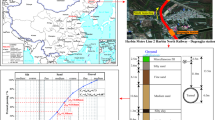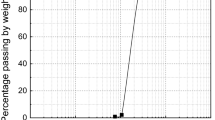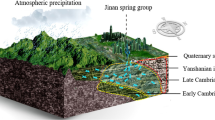In the hydrologic cycle, sandy soils play the role of a connecting reservoir of surface water and groundwater, particularly in arid areas. Therefore, to provide water conservation and ecological environment protection, it is important to study the soil water behavior in the unsaturated zone. At present, the CT-scan method is commonly used to study the soil hydraulic properties. In the field of materials science, the industrial CT high-resolution instruments are applied for quantitative research on the porous microstructure and fluid filtration law in sandy soils.
In this study, we have studied five samples of sand scans of the quartz sand and CUGB coarse sand types. The industrial-type CT instrument XTH225ST was used for the sample microstructure scanning. In order to identify water: air, and solid particle distribution of the sample cross section, and to analyze the particle size distribution and moisture content, the scanned images were processed using the VG-Studio and ImageJ software.
Comparing the CT-scan results of the four quartz sand samples, it can be concluded that the optimal particle size, ranges from 1 to 2 mm. According to the porosity quantitative analysis, with decrease in the particle size, the total porosity grate soil sample increases. After applying the image recognition and VG- Studio software, we can see that for different particle sizes of the sand sample, the average pore size increases with increase in the particle size.
To study the moisture absorption and desorption phenomenon, two samples of the CUGB coarse sand are experimentally studied. The particle size of the samples range: from 1 to 2 mm. The CT scanning analysis is used to obtain the unsaturated characteristic curve of the soil when the moisture content reaches stability. Due to the lag phenomenon, the characteristic curve of the soil moisture has an obvious “loop,” or hysteresis, shape. As shown by a 3D modeling, the distribution of capillary water in the sand column is complex, and the water flow forms multiple winding paths, like “worms” creeping in the soil.
The CT-scan method is used to overcome the limitations of the traditional experimental methods and to evaluate the relationship between the moisture content and the matrix suction. The obtained characteristic curve of soil moisture can be used to improve the efficiency of technological operations. The CT-scan method provides a new way of evaluating the water distribution characteristics of unsaturated soil.






Similar content being viewed by others
References
J. R. Wang and T. J. Schmugge. “An empirical model for the complex dielectric permittivity of soils as a function of water content,” IEEE Trans. Geosci. Rem. Sens., 4, 288-295 (1980).
D. Croney and J. D. Coleman, Pore Pressure and Suction in Soil, Butterworths, London (1961).
J. Lipiec et al., “Measurement of plant water use under controlled soil moisture conditions by the negative pressure water circulation technique,” Soil Sci. Plant Nutr., 34(3), 417-428 (1988).
M. K. Krokida and Z. B. Maroulis, “Effect of drying method on shrinkage and porosity,” Drying Technol., 15(10), 2441-2458 (1997).
J. Ledieu et al., “A method of measuring soil moisture by time-domain reflectometry,” J. Hydrol., 88(3-4), 319-328 (1986).
J. D. Tandy and M. Visvalingam, “The neutron method for measuring soil moisture content-a review,” J. Soil Sci., 23(4), 499-5l1(1972).
M. Rieu and G Sposito, “Fractal fragmentation, soil porosity, and soil water properties: I. Theory,” Soil Sci. Soc. Am. J., 55(5), 1231-1238 (1991).
T. C. Lippmann and R. A. Holman, “The spatial and temporal variability of sand bar morphology,” J. Geophys. Res.: Oceans, 95(C7), 11575-11590(1990).
D. J. Disraeli, “The effect of sand deposits on the growth and morphology of Ammophila breviligulata,” J. Ecol., 72(1), 145-154 (1984).
E. Y. Lee et al., “Effects of gelatinization and moisture content of extruded starch pellets on morphology and physical properties of microwave-expanded products,” Cereal Chem., 77(6), 769-773 (2000).
I. Fatt, “The network model of porous media,” Trans. AIME, 207(01), 144-181(1956).
R. P. Ewing and S. C. Gupta, “Modeling percolation properties of random media using a domain network,” Water Resour. Res., 29(9), 3169-3178 (1993).
G. S. Campell, “A simple method for determining unsaturated hydraulic conductivity from moisture retention data,” Soil Sci., 117, 311-314 (1974).
Y. Mualem, “A new model for predicting the hydraulic conductivity of unsaturated porous media,” Water Resour. Res., 12,513-522 (1976).
R. Van Genuchten, “Predicting the hydraulic conductivity of unsaturated soils,” Soil Sci. Soc., 44, 892-898(1980).
K. Roth, H. J. Vogel, and R. Kasteel, “The scaleway: A conceptual framework for upscaling soil properties,” Model. Trans. Proc. Soils, 1, 24-26 (1999).
M. Cyìslerova and J. Votrubova “CT derived porosity distribution and flow domains,” J. Hydrol., 267(3), 186-200 (2002).
A. Garbout, L. J. Munkholm, and S. B. Hansen, “Temporal dynamics for soil aggregates determined using X-ray CT scanning,” Geoderma, 204-205(4), 15-22 (2013).
A. Garbout et al., “Tillage effects on topsoil structural quality assessed using X-ray CT, soil cores and visual soil evaluation,” Soil Tillage Res., 128,104-109 (2013).
K. N. Manahiloh and C. L. Meehan, “Determining the soil water characteristic curve and interfacial contact angle from microstructural analysis of X-ray CT images,” J. Geotech. Geoenviron. Eng., 143(8), 04017034 (2017).
K. Beven et al., “Macropores and water flow in soils,” Water Resour. Res., 18(5), 1311-1325 (1982).
R. H. IL Brooks and A. T. Corey, Hydraulic Properties of Porous Media, Colorado State University, USA (1964).
J. F. Bruchon et al., “Fall 3D investigation and characterization of capillary collapse of a loose unsaturated sand using X-ray CT,” Gran. Matter, 15(6), 783-800. (2013):
Y. Higo et al., “Trinarization of ìX-ray CT images of partially saturated sand at different water-retention states using a region growing method,” Nucl. Instrum. Methods Phys. Res., 324, 63-69 (2014).
B. S. Nabawy and C. David, “X-Ray CT scanning imaging for the Nubia sandstone as a tool for characterizing its capillary properties,” Geosci. J., 20(5), 691-704 (2016).
T. Mukunoki et al., “X-ray CT analysis of pore structure in sand,” Solid Earth, 7(3), 929-942 (2016).
T. Muktmoki, N. Komano, et al., “Image analysis of soil failure on defective underground pipe due to cyclic water supply and drainage using X-ray CT,” Front. Struct. Civ. Eng., 6(2), 85-100 (2012).
Z. Otwinowski and W. Minor, “Processing of X-ray diffraction data collected in oscillation mode,” Methods Enzymol., 276(97), 307-326 (1997).
M. Paradelo, S. Katuwal, P. Moldrup, et al., “X-ray CT-derived soil characteristics explain varying air, water, and solute transport properties across a Loamy Field,” Vadose Zone J., 15(4), 1-13 (2016).
R. L. Peyton, C. J. Gantzer, S. H. Anderson, et al., “Fractal dimension to describe soil macropore structure using X ray computed tomography,” Water Resour. Res., 30(3), 691-700 (1994).
H. J. Vogel and R. Roth, “A new approach for determining effective soil hydraulic functions,” Eur. J. Soil Sci., 49, 547-556 (1998).
W. Tollner and B. P. Verma, “X-ray CT for quantifying water content at points within a soil body,” Trans. .ASAE, 32(3), 0901-0905 (1989).
Acknowledgments
This work was financially supported by the Basic Scientific Research CAGS (No. JKY201901-04, No. JYYWF20181101, and JKY202007), Geological Survey Projects of China Geological Survey (No.DD20190134 and the National Natural Science Fund Project (41877197 and 41602257).
Author information
Authors and Affiliations
Corresponding author
Additional information
Translated from Khimiya i Tekhnologiya Topliv i Masel, No. 1, pp. 92 - 96, January - February, 2021.
Rights and permissions
About this article
Cite this article
Zhao, T., Tang, Xc., Wang, Gl. et al. A Study on Characteristics of Unsaturated Sandy Soils Based on the CT Scanning Method. Chem Technol Fuels Oils 57, 160–172 (2021). https://doi.org/10.1007/s10553-021-01235-w
Published:
Issue Date:
DOI: https://doi.org/10.1007/s10553-021-01235-w




